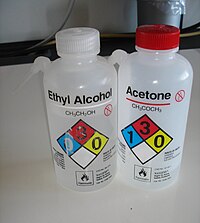From Wikipedia, the free encyclopedia
NFPA 704 is a standard maintained by the U.S.-based National Fire Protection Association. It defines the colloquial "fire diamond" used by emergency personnel to quickly and easily identify the risks posed by nearby hazardous materials. This is necessary to help determine what, if any, specialty equipment should be used, procedures followed, or precautions taken during the first moments of an emergency response.
[edit] Symbolism

Two plastic squirt bottles containing the
NFPA 704 color code for hazardous materials identification.
The four divisions are typically color-coded, with blue indicating level of health hazard, red indicating flammability, yellow (chemical) reactivity, and white containing special codes for unique hazards. Each of health, flammability and reactivity is rated on a scale from 0 (no hazard; normal substance) to 4 (severe risk).
| Health (blue) |
| 4 |
Very short exposure could cause death or major residual injury (e.g., hydrogen cyanide) |
| 3 |
Short exposure could cause serious temporary or moderate residual injury (e.g., chlorine gas) |
| 2 |
Intense or continued but not chronic exposure could cause temporary incapacitation or possible residual injury (e.g., ethyl ether) |
| 1 |
Exposure would cause irritation with only minor residual injury (e.g., turpentine) |
| 0 |
Poses no health hazard, no precautions necessary. (e.g., lanolin) |
| Flammability (red) |
| 4 |
Will rapidly or completely vaporize at normal atmospheric pressure and temperature, or is readily dispersed in air and will burn readily (e.g., propane). Flash point below 23°C (73°F) |
| 3 |
Liquids and solids that can be ignited under almost all ambient temperature conditions (e.g., gasoline). Flash point below 38°C (100°F) but above 23°C (73°F) |
| 2 |
Must be moderately heated or exposed to relatively high ambient temperature before ignition can occur (e.g., diesel fuel). Flash point between 38°C (100°F) and 93°C (200°F) |
| 1 |
Must be heated before ignition can occur (e.g., soybean oil). Flash point over 93°C (200°F) |
| 0 |
Will not burn (e.g., water) |
| Instability/Reactivity (yellow) |
| 4 |
Readily capable of detonation or explosive decomposition at normal temperatures and pressures (e.g., nitroglycerine, RDX) |
| 3 |
Capable of detonation or explosive decomposition but requires a strong initiating source, must be heated under confinement before initiation, reacts explosively with water, or will detonate if severely shocked (e.g. ammonium nitrate) |
| 2 |
Undergoes violent chemical change at elevated temperatures and pressures, reacts violently with water, or may form explosive mixtures with water (e.g., phosphorus, potassium, sodium) |
| 1 |
Normally stable, (but can become unstable at elevated temperatures and pressures)(e.g. Sodium hydroxide) |
| 0 |
Normally stable, even under fire exposure conditions, and is not reactive with water (e.g. helium) |
[edit] White - Special
The white "banda" area can contain several symbols:
W: reacts with Water in an unusual or dangerous manner (e.g., cesium, sodium)- OX or OXY: Oxidizer (e.g., potassium perchlorate, ammonium nitrate)
- SA: Simple asphyxiant gas (includes only nitrogen, helium, neon, argon, krypton, or xenon)
- COR: Corrosive; strong acid or base (e.g. sulfuric acid, potassium hydroxide)
- ACID and ALK to be more specific.
- BIO: Biological hazard (e.g., smallpox virus)
- POI: Poisonous (e.g. Spider Venom),
- The Radioactive trefoil (
 ): is radioactive (e.g., plutonium, uranium)
): is radioactive (e.g., plutonium, uranium)
- CRY or CRYO: Cryogenic (e.g. Liquid Nitrogen)
Note: Only W, OX/OXY and SA are officially part of the NFPA 704 standard, but other self-explanatory symbols are occasionally used in an unofficial manner. The use of non-standard symbols or text may be permitted, required or disallowed by the authority having jurisdiction (e.g., fire department). Even though it is officially part of NFPA 704, SA is often not used
[edit] See also
[edit] References
[edit] External links
 ): is radioactive (e.g., plutonium, uranium)
): is radioactive (e.g., plutonium, uranium)


